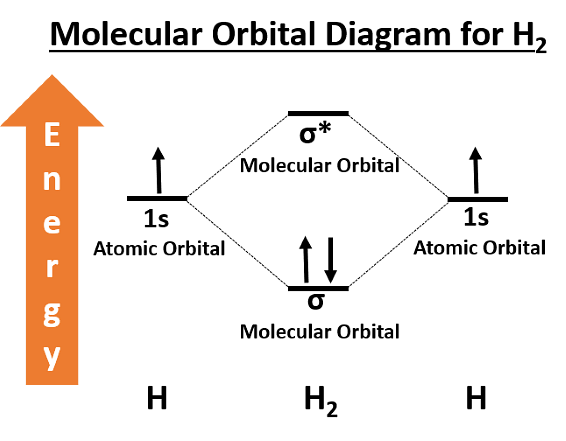The correct order of bond dissociation energy among $N_2, O_2, O_2^-$ is shown in which of the following arrangements ?
- $N_{2}> O_{2}^{-}>O_{2}$
- $O^{-}_{2}> O_{2}>N_{2}$
- $N_{2}> O_{2}>O_{2}^{-}$
- $O_{2}> O_{2}^{-}>N_{2}$
The Correct Option is C
Solution and Explanation
$N_{2} =Nb=10, Na=4$
$B.O.=\left(N_{2}\right)=\frac{10-4}{2}=3$
$O_{2}=Nb=10, Na=6$
$B.O_{\left(o_2\right)}=\frac{10-6}{2}=2$
$O_{2}^{-}=Nb=10, Na=7$
$B.O._{\left(o_2\right)}=\frac{10-7}{2}=\frac{3}{2}=1.5$
Hence the order of B.O.
$N_{2}>\, O_{2} >\, O_{2}^{-}$
Top Questions on Molecular Orbital Theory
- In the following, the number of paramagnetic molecules are: O\(_2\), N\(_2\), F\(_2\), B\(_2\), Cl\(_2\).
- JEE Main - 2025
- Chemistry
- Molecular Orbital Theory
Which of the following statement is true with respect to H\(_2\)O, NH\(_3\) and CH\(_4\)?
(A) The central atoms of all the molecules are sp\(^3\) hybridized.
(B) The H–O–H, H–N–H and H–C–H angles in the above molecules are 104.5°, 107.5° and 109.5° respectively.
(C) The increasing order of dipole moment is CH\(_4\)<NH\(_3\)<H\(_2\)O.
(D) Both H\(_2\)O and NH\(_3\) are Lewis acids and CH\(_4\) is a Lewis base.
(E) A solution of NH\(_3\) in H\(_2\)O is basic. In this solution NH\(_3\) and H\(_2\)O act as Lowry-Bronsted acid and base respectively.
- JEE Main - 2025
- Chemistry
- Molecular Orbital Theory
Which of the following linear combinations of atomic orbitals will lead to the formation of molecular orbitals in homonuclear diatomic molecules (internuclear axis in z-direction)?
(1) \( 2p_z \) and \( 2p_x \)
(2) \( 2s \) and \( 2p_x \)
(3) \( 3d_{xy} \) and \( 3d_{x^2-y^2} \)
(4) \( 2s \) and \( 2p_z \)
(5) \( 2p_z \) and \( 3d_{x^2-y^2} \)
- JEE Main - 2025
- Chemistry
- Molecular Orbital Theory
- Arrange the following in increasing order of bond order: (A) He\(_2^+\)
(B) O\(_2^-\)
(C) HF
(D) NO\(^-\)- CUET (PG) - 2025
- Chemistry
- Molecular Orbital Theory
- The sum of the bond orders of O$_2^+$, O$_2^-$, O$_2$, O$_2^{2-$, and the sum of the unpaired electrons in them respectively are
- AP EAPCET - 2025
- Chemistry
- Molecular Orbital Theory
Questions Asked in JEE Main exam
A point particle of charge \( Q \) is located at \( P \) along the axis of an electric dipole 1 at a distance \( r \) as shown in the figure. The point \( P \) is also on the equatorial plane of a second electric dipole 2 at a distance \( r \). The dipoles are made of opposite charge \( q \) separated by a distance \( 2a \). For the charge particle at \( P \) not to experience any net force, which of the following correctly describes the situation?

- JEE Main - 2025
- Electrostatics and Work Done by Electric Field
- The value of \( (\sin 70^\circ)(\cot 10^\circ \cot 70^\circ - 1) \) is:
- JEE Main - 2025
- Trigonometric Identities
- The area of the region enclosed by the curves \( y = x^2 - 4x + 4 \) and \( y^2 = 16 - 8x \) is:
- JEE Main - 2025
- Area between Two Curves
- 2.8 \( \times 10^{-3} \) mol of \( \text{CO}_2 \) is left after removing \( 10^{21} \) molecules from its ‘\( x \)’ mg sample. The mass of \( \text{CO}_2 \) taken initially is: Given: \( N_A = 6.02 \times 10^{23} \, \text{mol}^{-1} \)
- JEE Main - 2025
- Mole concept and Molar Masses
- A conducting bar moves on two conducting rails as shown in the figure. A constant magnetic field \( B \) exists into the page. The bar starts to move from the vertex at time \( t = 0 \) with a constant velocity. If the induced EMF is \( E \propto t^n \), then the value of \( n \) is ________________________.

- JEE Main - 2025
- Electromagnetic induction
Concepts Used:
Molecular Orbital Theory
The Molecular Orbital Theory is a more sophisticated model of chemical bonding where new molecular orbitals are generated using a mathematical process called Linear Combination of Atomic Orbitals (LCAO).
Molecular Orbital theory is a chemical bonding theory that states that individual atoms combine together to form molecular orbitals. Due to this arrangement in MOT Theory, electrons associated with different nuclei can be found in different atomic orbitals. In molecular orbital theory, the electrons present in a molecule are not assigned to individual chemical bonds between the atoms. Rather, they are treated as moving under the influence of the atomic nuclei in the entire molecule.
